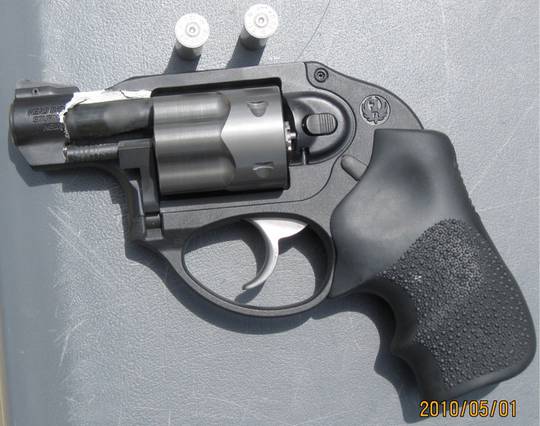Mike Lewis over at lmsdefense.com reports a student’s unsettling experience with the $575 (retail) Ruger LCR double action revolver. It’s all anecdotal folks, but this follows on the heels of a Smith & Wesson Scandium Model 329 PD .44 Magnum Revolver that sheared in half. The LCR is made of “aerospace grade” 7000 series aluminum. Is it time to ask if the increasing use of high-tech revolver materials—in pursuit of the lightest possible carry weight—is too far ahead of ballistic power?
I was conducting a Concealed Carry Handgun class on 1 May 2010. There was a student training with a Ruger LCR that she stated had less than 100 rounds previously fired through it. She was using CCI Blazer 158 grain TMJ +P ammunition, and had fired approximately 25 rounds so far in the course without any cause for concern.
The student was in the middle of firing a two round engagement drill under my supervision; she fired one round then informed me that she thought her trigger was “stuck”. I took the firearm from her, assuming that she had possibly taken the cylinder out of battery, and attempted to put the cylinder back into battery. Upon looking, I noticed that part of the frame subassembly (the barrel sheath portion) was blown off, and the barrel split. I checked to see if the cylinder was stable, and the cylinder turned slightly in my hand before apparently being bound by the split barrel. I was able to clear the weapon, at which point we removed it from the firing line and inspected shooters for injuries. As there were no injuries resulting from this failure, we examined the firearm and replaced it on the firing line with one of my revolvers a S&W J Frame that performed flawlessly), so she could continue training.
In my opinion, this was most likely not a shooter or ammunition-induced failure. I checked the owner’s manual to ensure that this firearm was rated for +P ammunition, which it is. The cylinder and topstrap show no visible damage; neither does the right side of the firearm.
It appears that the chamber was not properly aligned with the bore when the round fired, and that the bullet struck the forcing cone out of alignment. The bullet most likely took the path of least resistance, leading to the catastrophic failure of the barrel and frame subassembly.
I have spoken with the VP of Ruger, as well as sending a letter to him concerning this failure; he seemed to be very interested and understanding of our concerns.
I hope this is an isolated incident. If it is a design flaw, hopefully Ruger will issue another safety recall to fix the problems.
I will update once I have heard from Ruger.
And we’ll update on his update.





As a longtime mountain bike rider I am all too familiar with the 7000 series aluminum failures. Aluminum is much less flexible than steel. When a chromoly steel frame fails it weakens and bends before it breaks. On the other hand, aluminum develops thousands of microscopic fractures as it absorbs impact. When it fails, it fails catastrophically with sudden break that you can't see coming.
Anyway, steel or aluminum, I can't imagine that if this frame has fewer than 100 rounds of manufacturer approved ammo on it, that the failure is material related. It doesn't seem like enough stress to rack the frame so badly that it would knock the barrel out of alignment with the cylinder. And no revolver, aluminum or steel, is going to survive the discharge of a misaligned cylinder. My guess is that something mechanical failed that caused the cylinder not to seat correctly or that the metal had a flaw in it (which happens with steel, too).
Coming soon the new Petard .44 Magnum belt-mounted derringer …
Well , ———————-it's now December 2010—-
Where is the update ? ? ?
12/02/2010 where's the update ?
Update please…….
I was rather sad to see this had happened to a Ruger revolver knowing the quality workmanship that is put into each Ruger firearm , possibly the .38 special ammo may have been at fault maybe accidently over loaded to .357 magnum pressure ! I have had some terrible ammo over the years , dirty new .38 special ammo (PMC) that caused my Taurus model 85 to bind up , the cylinder could not even turn after firing the first round , I once had the rim fly off of a .22 short cartridge (Remington) right into my face after shooting a Colt .22 Junior ! I still prefer the steel revolvers over the aluminum , plastic “high” tech revolvers that are out today , I do not feel that they are completely perfected yet , maybe in another 10 years they will be !
I see no evidence as to the reason for the kaboom. How does the author know it wasnt a double charge round or a squib load and a blocked barrel?????
seeing that picture….that was my first thought. Doin double taps…first goes a little pop….brain reaction to muscle reaction is to long…and second round goes off…..boom, split barrel and frame, yet enough energy to get the two bullets out the front barrel.
And when yer talkin such a short barrel…under two inches…thats very possible.
This happened to me today with my ruguer lcr 9mm. 56th round through gun blew barrel apart with no warning or issues and rem 9mm fmj is the only ammo used
Comments are closed.